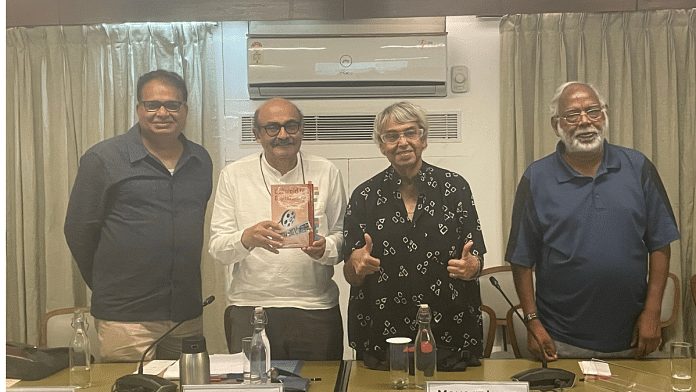New Delhi: Film societies have had a tremendous impact in taking Indian cinema to the world stage. Payal Kapadia’s success at the Cannes Film Festival’s Grand Prix is a shining example. But the onslaught of OTT and digital means newer challenges for these societies.
Journalist and author VK Cherian’s recently released book, Celluloid to Digital: India’s Film Society Movement, explores these challenges.
He cited the example of Talking Films Online, a digital platform for discussions on cinema. Co-founded by Gita Viswanath & Nikhila H in June 2020, it is a group of teachers, students, researchers, and cinephiles interested in talking and writing about cinema.
For the book discussion, Cherian was joined by writer-activist Shri John Dayal, film writer Monojit Lahiri, and IIC trustee Suhas Borker.
The conference room quickly filled with over 30 people, mostly retired IIC members and senior citizens, eager to hear about the seven-decade journey of the Film Society Movement (FSM).
However, an attendee, Poonam Arora, expressed disappointment at the crowd the book discussion had attracted.
She had hoped to see more young faces.
“They (IIC) themselves are not able to use the technology to its full potential to attract the young crowd, how will film societies do?” asked a cryptic Arora, who recently retired after a 20-year tenure teaching films at the University of Michigan.
A Nehruvian movement
The book discussion that went as back as 1947 — when Satyajit Ray co-founded the Calcutta Film Society — underlined the importance of two Indian prime ministers who were the “driving force” behind the growth and popularity of film societies: Jawaharlal Nehru and Indira Gandhi.
“Therefore, I call it the Nehruvian movement,” said Cherian.
Sharing an anecdote from those days, the author recalled when Pather Panchali was released, many felt that the filmmaker was trying to sell India’s poverty abroad.
“At that time, Nehru made a statement saying that, ‘If poverty is depicted with such sensitivity, I am all for it.’ And, that’s how the controversy died down,” Cherian shared.
Meanwhile, Indira Gandhi, first as the I&B minister and later as the PM, remained an ardent admirer of New Indian Cinema till her death.
The Federation of Film Societies of India (FFSI) was formed in 1959. And, Gandhi became associated with FFSI as its vice president.
The government also provided an exemption from censorship for FFSI-circulated films.
States were asked to provide entertainment tax exemption for screening by film societies.
From time to time, Gandhi intervened to ensure the exemption of taxes was not a deterrent for the smooth running of the film societies.
“In their (Nehru and Gandhi) leadership, there was a passion and a very strong involvement of the government. Today, we have lost all that,” Borker said.
The downfall & digital age
At one point in 2014, FFSI had 321 regular film societies and about 100 campus film societies.
But a lot changed.
According to Cherian, those left include CFS and its small group, Bangalore’s Suchitra and its cultural complex, Mumbai’s Prabhat Chitra Mandal, Gauhati Cine Club, FFSI Keralam and Delhi’s IIC/habitat film clubs.
Cherian also revealed that FFSI was given an annual grant of Rs 15 lakh to keep these societies up and running. But the last money order came in 2014.
In the foreword of Cherian’s book, Indian screenwriter and director Adoor Gopalakrishnan wrote, “Film society lost the unique position of being the one and only window to world cinema. However, as the world has changed…film societies are no longer the exclusive window on the best of films.”
With evolving modern technology — VHS tapes, CDs, blue rays and now the ubiquitous pen drives and internet — many classics are now available to the public for free.
The FSM, according to Borker, is in “transition” and requires a “new creative process”.
“There’s currently a vacuum, and when there’s a vacuum, something will emerge,” he added.
Academic groups like Talking Films Online could be one solution, suggested Cherian.
Cherian doesn’t see a future for FFSI unless they also undergo a change to suit the digital era.
“It will be difficult for them to survive. The academics, on the other hand, who are studying films, will take this type of film appreciation forward,” he concluded.
(Edited by Humra Laeeq)







Thanks for th4 article…and naming Adoor..
KIndly correct the name KS GOpalakrishan in the heading. As he has nothing to do with FSM..The person who wrote the Forward is Adoor Gopalakrishnan